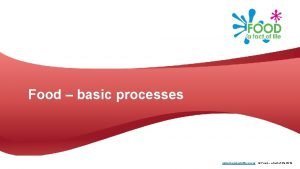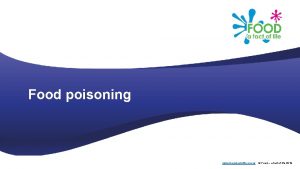Raising agents www foodafactoflife org uk Food a













- Slides: 13

Raising agents www. foodafactoflife. org. uk © Food – a fact of life 2019

Raising agents include anything that causes rising within foods, and are usually used in baked goods. Raising agents are added to baked products during the preparation stage. They create gas, air or steam which expands when heated and causes the food to rise. When heated, the gas that is trapped within the product expands. This is because heating causes the molecules in the air to move more rapidly and apply more force. This rising results in a light and airy texture within foods. Examples of mixtures that require aeration are: • cakes, bread, batters, pastries, meringues, soufflés. www. foodafactoflife. org. uk © Food – a fact of life 2019

Different types of raising agents There are different types of raising agents that can be used. These can be: • mechanical; • chemical; • biological. Different foods may use one or more of these to achieve a desirable end product. www. foodafactoflife. org. uk © Food – a fact of life 2019

Mechanical raising agents Air is a commonly used and effective raising agent. It can be added to a mixture in a variety of ways: • sieving flour or lifting flour when rubbing in fat, e. g. pastry, scones, cakes; • creaming fat and sugar to incorporate air, e. g. creamed cake mixture; • whisking to trap air e. g. Eggs, whisked to create a foam for sponge cakes, meringues, soufflés; • beating ingredients together helps to trap air, e. g. beating eggs into a creamed mixture; • rolling and folding pastry (creating laminations) traps air, e. g. flaky pastry, rough puff pastry. www. foodafactoflife. org. uk © Food – a fact of life 2019

Steam as a raising agent Steam is a common physical raising agent. It is produced from the liquids (e. g. water, milk, eggs) that are added to mixtures, or from water contained in a solid component (e. g. butter). Examples of recipes which use steam as a raising agent are batters (e. g. Yorkshire pudding) and choux pastry. They require a high oven temperature to produce the steam to raise the mixture. This produces a light, open texture with large pockets of air left after the steam has escaped. Steam also works with air and carbon dioxide in cakes and bread, as well as with air in pastry, to help increase their volume. www. foodafactoflife. org. uk © Food – a fact of life 2019

Chemical raising agents are those that require a chemical reaction in order to function. Common examples of chemical raising agents include: • baking soda (bicarbonate of soda); • baking powder (bicarbonate of soda + cream of tartar); • self-raising flour. Baking soda is an alkali that reacts with an acid (in the presence of water) to produce carbon dioxide, which causes rising. Baking powder is baking soda with an acid (e. g. cream of tartar) already present, so only water need be added. Self-raising flour is flour that already contains baking powder, and therefore only requires water to be activated. www. foodafactoflife. org. uk © Food – a fact of life 2019

Biological raising agents Yeast is a biological raising agent. There are different types of yeast available that can be used to make bread and bread products. These are: fresh yeast, dried yeast and easy-blend yeast. Given the right conditions (warmth, carbohydrates and moisture) yeast converts sugars to alcohol and carbon dioxide. This is called fermentation. The carbon dioxide in the bread dough will expand when placed in a hot oven; steam is also produced to help raise the dough. www. foodafactoflife. org. uk © Food – a fact of life 2019

Biological raising agents The conditions that affect yeast fermentation are: • temperature: the best temperature range for yeast is between 25° - 35°C. If the temperature is too high the yeast cells are destroyed, if too low the action is slowed; • moisture: this is provided by the liquid in the dough; this should be at the correct temperature; • food: this is supplied by the starch in the flour. www. foodafactoflife. org. uk © Food – a fact of life 2019

Biological raising agents Other ingredients can also affect the action of the yeast. • salt: excess will slow the action of the yeast by drawing the water out of the cells and destroying them; • fat: a high fat content will slow the action of the yeast; rich dough recipes often have a higher proportion of yeast to flour. • sugar: normally, adding sugar will speed up yeast growth, but large excesses of sugar can bind water and actually inhibit yeast growth. www. foodafactoflife. org. uk © Food – a fact of life 2019

Combining raising agents The different types of raising agents are sometimes used together to aerate a mixture. A creamed cake mixture is a good example. This uses: • mechanical: air is added by sieving the flour, creaming the fat and sugar, beating in the egg; • physical: steam is formed from the liquids during cooking; • chemical: carbon dioxide is released from the baking powder or self raising flour when the liquid is added and during cooking. www. foodafactoflife. org. uk © Food – a fact of life 2019

How raising agents work - summary The appropriate raising agent is added to the mixture and is evenly distributed. When it is heated one or more of the following will take place: • air will expand; • steam is produced from liquids and enlarges the air cells, the steam escapes and is replaced by air; • carbon dioxide is produced when moisture and heat act on baking powder (or similar), the carbon dioxide enlarges the air cells and aerates the mixture. The gases expand when they are heated. • carbon dioxide produced by yeast cells expands due to the heat of the oven. www. foodafactoflife. org. uk © Food – a fact of life 2019

How raising agents work Additional information • gluten in flour allows mixtures to stretch as the reactions take place; • mixtures must rise before the protein in the flour/egg coagulates during the cooking process; • when coagulation takes place the mixtures sets in its risen shape. The type of raising agent used will affect the final texture and appearance of the dish. www. foodafactoflife. org. uk © Food – a fact of life 2019

Raising agents For further information, go to: www. foodafactoflife. org. uk © Food – a fact of life 2019
 Chemical raising agent
Chemical raising agent Www.foodafactoflife.org.uk
Www.foodafactoflife.org.uk Foodafactoflife explore food
Foodafactoflife explore food Symptoms of food poisoning
Symptoms of food poisoning Food a fact of life
Food a fact of life Foodafactoflife
Foodafactoflife Www.foodafactoflife.org.uk
Www.foodafactoflife.org.uk Www.foodafactoflife.org.uk
Www.foodafactoflife.org.uk Www.foodafactoflife.org.uk
Www.foodafactoflife.org.uk Www.foodafactoflife.org.uk
Www.foodafactoflife.org.uk Food improvement agents package
Food improvement agents package Unit 2 food food food
Unit 2 food food food Grazing food chain diagram
Grazing food chain diagram Foodafactoflife
Foodafactoflife























